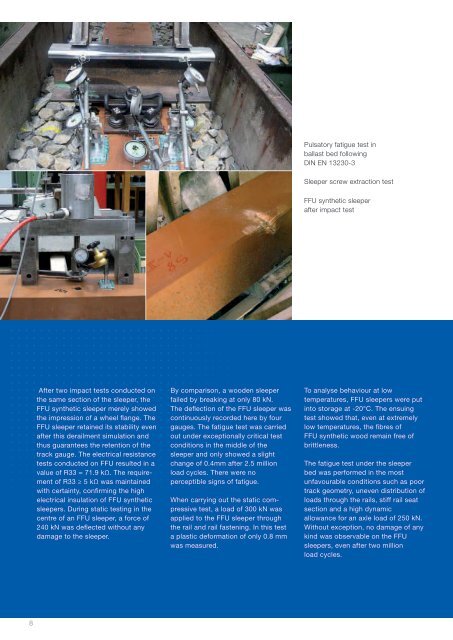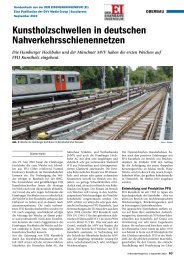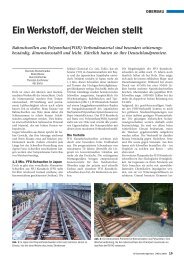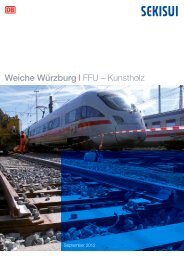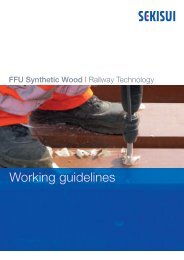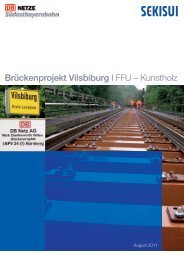FFU Synthetic Sleeper I Railway Technology
FFU Synthetic Sleeper I Railway Technology
FFU Synthetic Sleeper I Railway Technology
Create successful ePaper yourself
Turn your PDF publications into a flip-book with our unique Google optimized e-Paper software.
Pulsatory fatigue test in<br />
ballast bed following<br />
DIN EN 13230-3<br />
<strong>Sleeper</strong> screw extraction test<br />
<strong>FFU</strong> synthetic sleeper<br />
after impact test<br />
After two impact tests conducted on<br />
the same section of the sleeper, the<br />
<strong>FFU</strong> synthetic sleeper merely showed<br />
the impression of a wheel flange. The<br />
<strong>FFU</strong> sleeper retained its stability even<br />
after this derailment simulation and<br />
thus guarantees the retention of the<br />
track gauge. The electrical resistance<br />
tests conducted on <strong>FFU</strong> resulted in a<br />
value of R33 = 71.9 kΩ. The requirement<br />
of R33 ≥ 5 kΩ was maintained<br />
with certainty, confirming the high<br />
electrical insulation of <strong>FFU</strong> synthetic<br />
sleepers. During static testing in the<br />
centre of an <strong>FFU</strong> sleeper, a force of<br />
240 kN was deflected without any<br />
damage to the sleeper.<br />
By comparison, a wooden sleeper<br />
failed by breaking at only 80 kN.<br />
The deflection of the <strong>FFU</strong> sleeper was<br />
continuously recorded here by four<br />
gauges. The fatigue test was carried<br />
out under exceptionally critical test<br />
conditions in the middle of the<br />
sleeper and only showed a slight<br />
change of 0.4mm after 2.5 million<br />
load cycles. There were no<br />
perceptible signs of fatigue.<br />
When carrying out the static compressive<br />
test, a load of 300 kN was<br />
applied to the <strong>FFU</strong> sleeper through<br />
the rail and rail fastening. In this test<br />
a plastic deformation of only 0.8 mm<br />
was measured.<br />
To analyse behaviour at low<br />
temperatures, <strong>FFU</strong> sleepers were put<br />
into storage at -20°C. The ensuing<br />
test showed that, even at extremely<br />
low temperatures, the fibres of<br />
<strong>FFU</strong> synthetic wood remain free of<br />
brittleness.<br />
The fatigue test under the sleeper<br />
bed was performed in the most<br />
unfavourable conditions such as poor<br />
track geometry, uneven distribution of<br />
loads through the rails, stiff rail seat<br />
section and a high dynamic<br />
allowance for an axle load of 250 kN.<br />
Without exception, no damage of any<br />
kind was observable on the <strong>FFU</strong><br />
sleepers, even after two million<br />
load cycles.<br />
8


